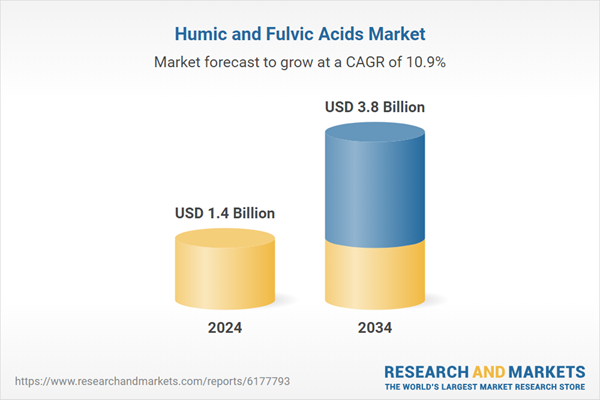This growth is fueled by a widespread shift in agriculture toward more sustainable soil enhancement methods and reduced dependency on synthetic fertilizers. Humic and fulvic acids play a vital role in improving soil quality, nutrient absorption, and plant productivity, which is increasingly important amid rising environmental concerns. As the emphasis on regenerative farming intensifies, these substances are gaining traction as core components of eco-friendly crop input strategies. Regulatory support, growing interest in bio-based soil additives, and a broader movement toward climate-smart agriculture continue to drive demand. Adoption is further supported by advanced farming techniques integrating humic and fulvic acids into precision application systems. Through methods such as fertigation, foliar feeding, and digital monitoring, users can fine-tune application for maximum crop efficiency. North America remains the largest market, benefiting from a well-established agriculture infrastructure and increased investment in sustainable technologies, giving humic and fulvic acids strong momentum in both conventional and organic farming systems.
The humic acid products segment held 62% share in 2024 and is expected to grow at a CAGR of 10.7% through 2034. Their widespread use stems from strong results in enhancing soil texture, retaining nutrients, and fostering plant development. Available in liquid, powder, and granular formats, these products support diverse usage across multiple agricultural settings. Fulvic acid products, while still a smaller segment, are witnessing accelerated adoption due to their enhanced nutrient chelation abilities, particularly in fertigation systems and foliar applications. This increased uptake is helping improve plant resilience and nutrient efficiency.
In 2024, the leonardite and coal-derived sources segment reached USD 920.1 million and will grow at a CAGR of 10.7% due to their rich humification levels and consistent quality, making them ideal for extracting concentrated humic substances. Deposits from regions like North America and Europe are widely used in agricultural and environmental applications, with their high carbon content and performance capabilities fueling the expansion of biostimulant-grade and soil amendment products.
North America Humic and Fulvic Acids Market held 38.2% share in 2024. The rise in regenerative farming, organic cultivation, and eco-labeled agricultural inputs continues to elevate demand for natural soil conditioners. With a strong culture around environmentally responsible farming, farmers and agribusinesses are increasingly turning to humic and fulvic acid products to enhance crop yield and soil vitality. The trend is further reinforced by consumer preference for food grown with clean, sustainable inputs.
Key players shaping the competitive landscape of the Global Humic And Fulvic Acids Market include Humatech, Inc., Canadian Humalite International Inc., Shandong Chuangxin Humic Acid Technology Co., Ltd., Humintech GmbH, Grow More, Inc., Horizon Ag-Products, LLC, Omnia Specialities Australia Pty Ltd., The Andersons, Inc., Novihum Technologies GmbH, Inner Mongolia Yili Humic Acid Ecological Technology Co., Ltd., Humic Growth Solutions, Inc., Jiloca Industrial, S.A., Black Earth Humic LP, Bio Huma Netics, Inc., and Humatech, Inc. To secure stronger market positioning, companies in the humic and fulvic acids sector are investing in advanced formulation technologies to enhance product efficacy and ease of use. Many are expanding product lines across granular, liquid, and soluble forms to cater to varied application methods.
Comprehensive Market Analysis and Forecast
- Industry trends, key growth drivers, challenges, future opportunities, and regulatory landscape
- Competitive landscape with Porter’s Five Forces and PESTEL analysis
- Market size, segmentation, and regional forecasts
- In-depth company profiles, business strategies, financial insights, and SWOT analysis
This product will be delivered within 2-4 business days.
Table of Contents
Companies Mentioned
The companies profiled in this Humic and Fulvic Acids market report include:- Bio Huma Netics, Inc.
- Black Earth Humic LP
- Canadian Humalite International Inc.
- Grow More, Inc.
- Horizon Ag-Products, LLC
- Humatech, Inc.
- Humic Growth Solutions, Inc.
- Humintech GmbH
- Inner Mongolia Yili Humic Acid Ecological Technology Co., Ltd.
- Jiloca Industrial, S.A.
- Novihum Technologies GmbH
- Omnia Specialities Australia Pty Ltd.
- Shandong Chuangxin Humic Acid Technology Co., Ltd.
- The Andersons, Inc.
Table Information
| Report Attribute | Details |
|---|---|
| No. of Pages | 190 |
| Published | September 2025 |
| Forecast Period | 2024 - 2034 |
| Estimated Market Value ( USD | $ 1.4 Billion |
| Forecasted Market Value ( USD | $ 3.8 Billion |
| Compound Annual Growth Rate | 10.9% |
| Regions Covered | Global |
| No. of Companies Mentioned | 15 |









